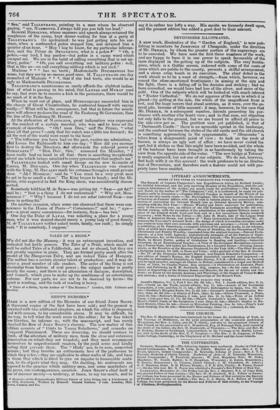DEVONSHIRE ILLUSTRATED.
A NEW work, illustrative of the " Garden of England," is now pub- lishing in numbers by JENNINGS of Cheapside, under the direction of Mr. DEEBLE, by whom the greater portion of the engravings are to be executed. We have seen the first three numbers of the work, and are happy to have it in our power to speak favourably of the taste displayed in the getting up of the subjects. The very frontis- piece, which is a Gothic screen, indorsed with some of the coats of arms which are public to the county, presents a skilful arrangement, and a clean crisp touch in its execution. The chief defect in the work struck us to be a want of strength,-from which, however, we except the afore-mentioned frontispiece : in aiming at the airy and the light, there is a falling off in the decisive and striking ; had we been consulted, we would have had less of the silver, and more of the gold. One of the subjects which will be looked at with much interest is " Exeter Cathedral." We do not approve of the view in which it is placed-by getting at the side, the whole of the magnificent front is lost, and the huge towers that stand sentries, as it were, over the ge- neral pile, become of little account: it may, however, be the case that Mr. DEEBLE, in a subsequent number, intends presenting his pur- chasers with another (the front) view ; and in that case, our objection not only falls to the ground, but we are bound to afford all praise to the side-view per se. The prettiest view yet published, is that of " Dartmouth Castle :" there is an agreeable spread in the landscape, and the contrast between the styles of the old castle and the old church is something approaching to the epigrammatic. " Ilfracombe " is taken from a disagreeable point of view : to look on the roofs of houses, is always an ugly sort of affair : we have never visited the spot, but it strikes us that this might have been avoided, and the whole of the harbour have been brought in as handsomely by taking the view from the opposite side of the water. " The new bridge at Totness" is neatly engraved, but not one of our subjects. We do not, however, find fault with it on this account : the work professes to be an illustra- tion of Devonshire, and therefore such a feature could not with pro- priety have been omitted.


















 Previous page
Previous page